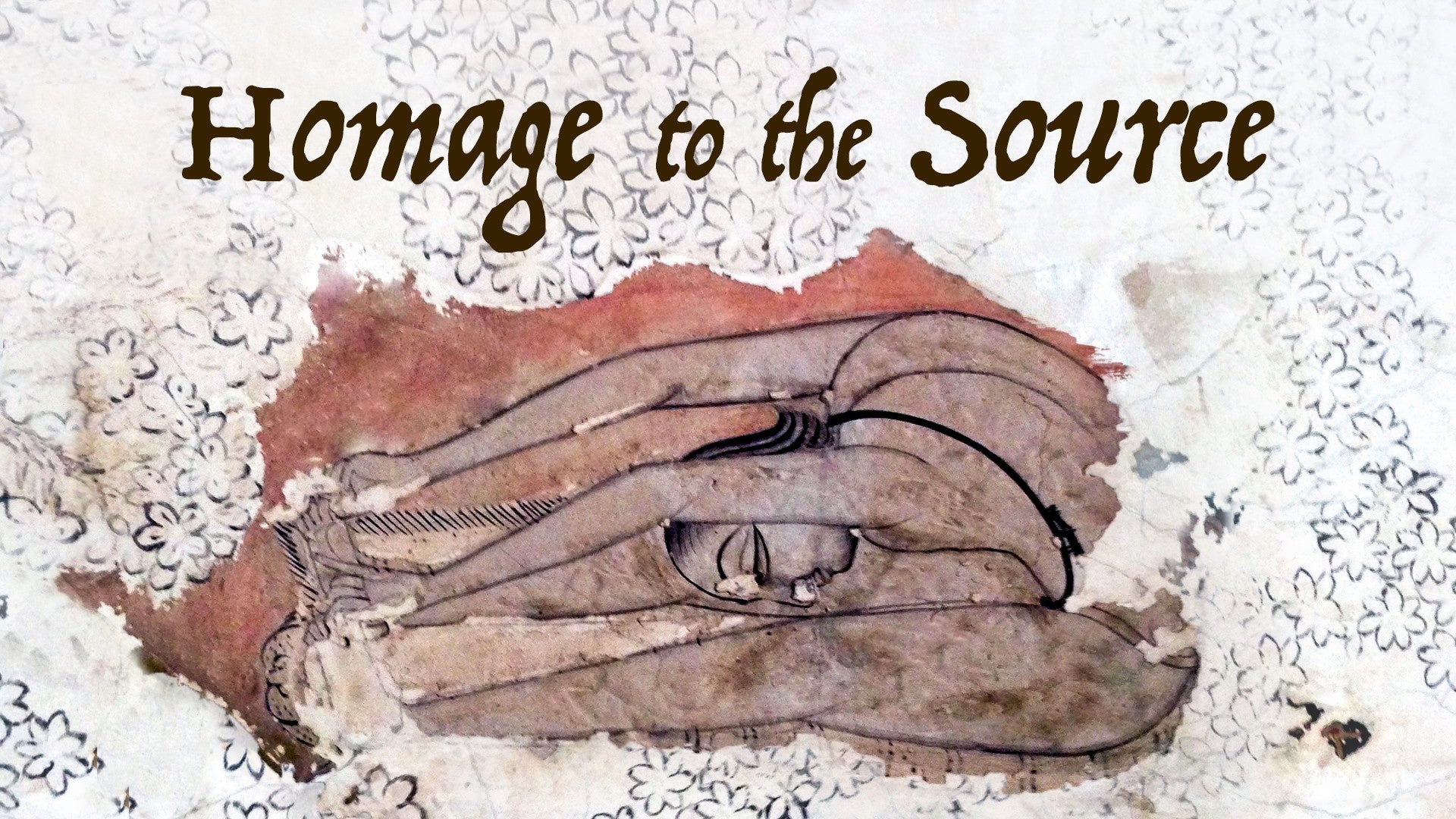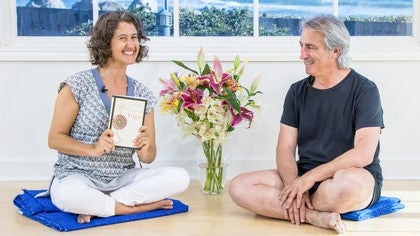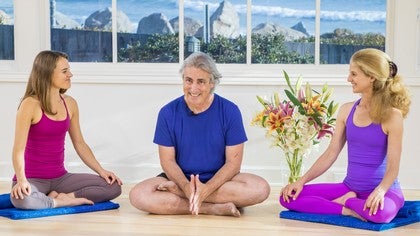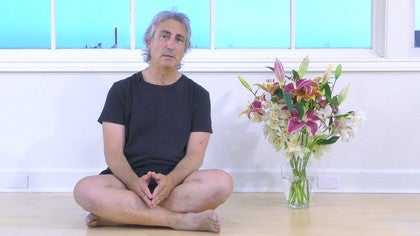Description
About This Video
Transcript
Read Full Transcript
Thank you for being here, and thank you Richard for being here. It's just been such a joy. Thank you. So we've got an exciting new show happening, Amish to the Source, which is based on one of Richard Rosen's books, Original Yoga, but according to the rumor, Amish to the Source was the title that you wanted. Yes, that's true. And the publisher changed it to Original Yoga. So as you were working on this book, what were some of the primary questions driving your research, your study? What were you hoping to find out? I'm interested in traditional yoga and what it was like. There's no one traditional yoga. There's different schools of traditional yoga, and I was wondering what it was that motivated people to do the practice in the old days. And not only that, but what the practice could teach us today. I felt like a lot of the old practices were not any longer appropriate for modern practitioners, but then I also felt that there were a few that could help us. There was no point in reinventing the wheel. And so I was looking to see what we could, what needed to be left off, but also what we might be able to revive it and use for our own benefit. So that I was looking at two things. I was looking to see, you know, what was no longer relevant to the modern practitioner in the 20th century when I wrote that book, or the 21st century. But I was also looking for things that still were relevant, that were missing from modern yoga, that would advance modern yoga beyond the merely physical practice that it primarily is right now today, and bring a more soulful or spiritual element into the practice. And so in that research, what were some of the most surprising findings? Whether, what were practices that were no longer relevant, or what were some of the threads that you chose to pull through? Well, of course, something that I'd known for a while that is becoming more, becoming more better known nowadays is that is that the asanas are a preliminary stage. If you go into the old texts and look at the length of the different chapters that are dedicated to different practices, generally speaking, the asana chapters are usually the shortest or among the shortest. And the longer chapters are generally speaking, dedicated to pranayama and the mudras. So one of the first things I discovered was that the mudras were quite considerably more important in the old practices than they are today, because they were interested in generating and channeling and preserving energy in the body. And that's what the mudras do. The mudras are often, mudras often translated with the word bond or seal, but I prefer to use the word valve. You just turn these things to hold energy in the physical body and then move it through the body for various reasons. So one thing I found was that the asanas, while important to the practice, took a back seat to other practices. The other thing I found that was very interesting was that we don't have a lot of meditation in modern hata yoga. That's usually left to the Buddhists, so that when we bring a meditation practice into a hata class, it usually comes from Buddhism. And in some way or another, that's been my experience anyway. And what I discovered is that there is indeed quite a bit of meditation in traditional yoga. And so the other thing that I'm interested in doing is reviving some of these meditations. Some of them are not particularly easy to do. They're quite elaborate visualizations of various things and not particularly appropriate for modern Westerners, but some of them can be used quite easily with people nowadays. So I'm interested in taking the traditional practice and adjusting it. I don't want to use the word. I don't want to distort the practice particularly. I want to try to preserve it in its original form as much as is possible and yet make it useful for people in our time and place. So as a translator of these practices for the more modern yogi, what have you found is working, is taking seed and root? Well, every one of my classes, whether a public class or a workshop or whatever I do, I always end the class with a pranayama practice. A lot of people find that to be unusual because they're not used to that. I think that most yoga classes nowadays, well, I'm not sure this is so true anymore, but for a very long time yoga in this country has been equated or conflated maybe is the right word with asana, so that when you go to a yoga class, a typical yoga class in this country, it's truthfully it's an asana class. And of course, so the first thing that's important to me is that I'm trying to remind students that the breathing practice is as important or more important than the asana practice. For me it is. And some people respond to this and they come back to my classes and some people ask me at the end of classes, there's something that you do without all that breathing and they don't appreciate it and they don't really get the importance of it. And I tell them then very frankly and very truthfully that you're not in the right class and that you need to find someone else that will give you more of what you're looking for. And so what's your sense? Why is it that the asana has been so predominantly what has taken hold and captured the attention of the Western yogi? Well, you know, Hatha yoga, the story goes, that was it was dying out toward the end of the 19th century in India and it was then revived in the early part of the 20th century by a number of different teachers, most popularly among them Mr. Krishna Macharya. And the intent was to make Hatha yoga more accessible to a broader audience. It had never been a mass movement in the past. It was always restricted to a group of initiates, relatively small group relative to the entire population of India. And so when the practice was, when the teachers intended to make the practice more accessible and more interesting to a mass audience, they of course had to get rid of a few of the practices that were on the dangerous side or inappropriate for a mass audience. And in their place they added what were exercises from various other disciplines like wrestling and gymnastics and things like that.
Hanuman Asana, for example, of course is the splits. It was given a yogic name or a Sanskrit name to make it seem yogic, but in fact it's the Western splits. And the Asanas were added and given these names that sort of jazzed them up a little bit to make them more appealing to a mass audience. And this is what came to this country in beginning in maybe the late 40s, 50s and early 60s. And it was a totally appropriate practice for us Westerners. We are doers. We like to do things. We like to create things and we'd like to see some results from that doing. And so the Asanas were designed to give us something to do and the exercises were indeed quite effective in certain ways. And we did, after some practice experience, the results of these exercises. And it was quite attractive because they were changing us in many significant physical ways. And I think personally that I think it's totally appropriate. Asana has always been the foundation for Hatha yoga and that's what we've been doing in this country for the last 60 or 70 years is creating a foundation for our practice. So I have no trouble with the emphasis on Asana. I think though that it's time that we've maybe stepped out a little bit of that comfort zone and started doing something else. Now it's my understanding mostly from Mark Singleton's work, Yoga Body, and Thanks Mark. And from other research though that the Asana practice being the aspect of yoga that's easiest to see. So as the practices of yoga started to be exported from India through the use of photography and other things it's what people could see. Because when Vivekananda came here in 1893 there was a very strong, and he seemed to flip-flop a little bit, but there was a very strong rejection of Asana going on in India. Well Hatha yoga in general. And can you speak a little bit as to why such a rejection of the Hatha yoga in India? Well because the Hatha yogis early on were seen as being very powerful and very very frightening characters. And under the influence of Western colonialism the yogis were stripped of their powers, of their position in the culture, and gradually were diminished in the eyes of the Indian middle-class, upper-class. And by the time that Vivekananda came to this country in 1893, he was an upper middle-class person. He was a self-proclaimed Swami. Nobody initiated Vivekananda into a lineage, he just called himself a Swami. And he, like many of his social equals in India, the upper middle-class, looked down on Hatha yogins who were seen as being charlatans or tricksters. And when he came to this country, the attitude toward Hatha yoga was that it wasn't really spiritual practice and it was physical practice. And had Vivekananda's yoga been the only yoga that we experienced, we would not be doing much yoga nowadays. It was Vivekananda was originally came to this country to raise money for social social projects that he had in India. But he ended up as a defender of Hinduism and taught a form of meditation as his form of yoga. But his audience was primarily upper middle-class Americans, because he was looking for money. So it was not very exciting, at least in the way we look at yoga excitement. And he came back to, he came to this country and stayed for I think about a year and a half originally, beginning in September, mid 1893, left the country, went back to India where he was received as a hero. And then he came back to this country or came back to the West a few years later. And he was by then, he had had his 15 minutes of fame and he did not create the same kind of excitement that he did the first time here. And so the early practice of yoga in this country was strictly meditation. And we don't see the kind of yoga that we are accustomed to seeing until the late 40s. And of course, the person who was the first public, really the first public presenter of Hatha yoga was Indra Devi, who was a Russian or Lithuanian, I believe, who took the stage name of Indra Devi when she was in India. And she was a Krishna Macharya's first female student. And so we, our attitude toward Hatha yoga was influenced by Vivekananda for all those years until we started practicing under the second wave of Indians. I won't go any farther than that. It was Indra Devi who really, really, really helped to bring yoga to this country, the kind of yoga that we're accustomed to. It's funny how she always gets left out when people name Krishna Macharya's students. Yes, that's unfortunate. And I've tried over the years to correct that because it's really not fair. She was a remarkable woman and she persisted against great odds. I mean, it wasn't easy to be a student of Krishna Macharya's if you were a male. And to be a female and be a student of his was nearly impossible. I believe, and I could be wrong here, but he tried to drive her away. He only accepted her as a student because he was forced to by his patron and she didn't give in. She was a very persistent female and she eventually won his admiration, his trust in admiration, and she became the first female teacher that he qualified to teach yoga.
Now, one thing that was common under my understanding with both Vivekananda and then this second wave is that the primary students were upper middle class women with financial means and leisure time. And it seems that this group is such a force in the nurturing of yoga in this country. Do you have anything to say on that? Well, it's a huge irony because for hundreds of years it was just males. Basically, there were probably some female students and some female teachers. There are records and later on in Hatha yoga in the later centuries, I shouldn't say commoners, but householders were admitted into the fold. Although they were never considered to be the most serious practitioners, those were the initiates that were. But of course it was mostly males and it mostly still is males in India. And so that's a huge irony. I think that in this country, the most recent survey, I don't remember exactly what year that is, but it's something like 80% of all the students in this country are females, women. And not only women, but they're quite well off women. They earn upwards of $75,000 a year, which is quite a bit of money if you're not living in Berkeley. And they are well educated. They've been to college and a lot of them have postgraduate degrees. So Hatha yoga has gone from wandering mendicant, semi-literate males to upper middle class, fairly well off, well educated females. And I always think that's kind of funny. So then one of the primary questions might be if these texts and these practices that we're bringing forth are primarily from a lineage of men, are these really the right practices for us? Probably not. I think one of the things that we have to we have to start exploring in this country, you see a yoga, and the Indians claim yoga as their own. I'm gonna make a lot of enemies when I say this, but yoga was born in India, grew up in India. The Indians raised yoga, so to speak. And now yoga has left home. The same thing has happened with me and my daughter. She was born in my family, we raised her, we nurtured her, and now she's reached the age where she's gone out. And now we still claim her as our daughter, but she's her own person now. And we have to let go now that she's a mature human being. This to me is analogous to yoga. In other words, yoga was born in India at least 2,500 years ago, not 5,000. It grew up in India. The Indians nurtured it, which we owe the Indians a great debt of gratitude for doing that. But now yoga has gone international. It's moved out of its house, and I think it's time for the Indians to recognize that and let it go and let it go on its own way. However, now that it has moved out, it's time also for it to be adapted to a new environment. You can't take yoga out of an Indian context, rip it up and transplant it. You can't take a palm tree and plant it in the Arctic. That's kind of an extreme example, but the thing about yoga in this country now, a lot of people are trying to preserve yoga as it was traditionally, and they're doing a lot of things like chanting in Sanskrit and taking on Hindu names and a lot of stuff that is fine. But I think eventually we're going to have to recognize the fact that we have to begin to adapt yoga to a new time and place and to make it more appropriate for Western transformation. What that's going to look like, I'm not really sure. But obviously the way it's set up nowadays is not complete. Obviously physically we have taken yoga as far as they've ever been taken. The Iyengar method has developed the asanas to a point where they are finally tuned and honed. I don't think there's much more that we can do with them in that regard. So now we have to start thinking about what's missing in modern yoga, the breathing, the meditation, that kind of practice is what we have to now bring to it. Respecting the tradition, we have to remember that we owe a lot to the old tradition, but at the same time we need something a little bit different to accommodate the new order. And so what you've done in this show is you've shared the story of how you came to these 32 asanas and then working with Betsy and Alana to share these. But what was so amazing in watching Richard's teaching is he just can't help but care and see the people in front of him, which is really the call of the yogi. They meet the situation in front of you. And so even though the project was to share these 32 quote-unquote original asanas, it's not yoga unless it's meeting the situation. That's entirely new. I mean in the old days yogis worked pretty much for themselves and liberation was an individual thing. There might have been some idea at some time of helping others around them, but the idea that yoga is a social movement that is meant to improve the society as a whole, it's brand new. It's a Western idea and I think that's a really important part of what we've, a really important thing that we've contributed to the yoga movement and that is yoga is for everybody. It's not just for a limited select group of males but it's for males, females, young, old, healthy, not so healthy. We don't in our schools don't discriminate between people that come in through the door. We try to accommodate whoever it is and I think that's a brand new thing for yoga. I think it's a very important aspect of what we've contributed, the West has contributed to yoga and that is you want to do yoga? Come on in because we can accommodate you in one way or the other. So thank you Richard. Thank you. Thank you for inviting us into the history as well as us inviting us to allow the history to help us find out who we are. Thank you for inviting me down to this beautiful place which I love and I enjoyed my time here very much with all of you. I hope you'll come back often. You just say the word and I'll be here. So please enjoy Amish to the Source and then also of course I'm just gonna make a plug for Richard's other show on the site, The Pronium in Meditation. Love.
Homage to the Source
Comments
You need to be a subscriber to post a comment.
Please Log In or Create an Account to start your free trial.













